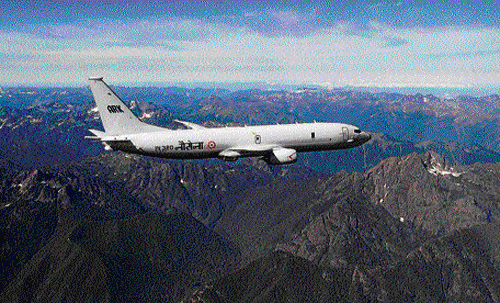
With China demonstrating its blue water ambition, the Indian Navy is all set to acquire its first US-made long-range surveillance aircraft, which can be used to keep an eye on the Chinese movements.
The first of the aircraft, known as P8I Poseidon, is expected to land in India around May 15, said a navy official. The US-origin aircraft will be based in INS Rajali, a naval base on the Tamil Nadu coast.
With a range of 8600 km and an endurance of 10 hours, P8I Poseidon can fly non-stop up to Australia – much beyond India’s neighbouring maritime zones – and augment Navy’s surveillance capability by leaps and bounds.
India is buying eight P8I, manufactured by Boeing, at a cost of $2.1 billion. These aircraft will replace the Russian Tu-142, inducted 25 years ago. The Navy will receive the first three in 2013 and the remaining five will arrive by 2015. India is the first customer of P8I, outside the USA.
New Delhi is negotiating with Washington to buy four additional P8Is from Boeing for further expanding its maritime footprint.
Acquisition of 12 P8I will complete the first phase of the Navy’s requirement of 24 long range maritime reconnaissance aircraft.
“The Russian-origin surveillance aircraft IL-38, which were later fitted with Sea Dragon suite for improved performance, would continue to fly for at least one more decade,” said Rear Admiral D M Sudan, assistant chief of naval staff in charge of air operations at Navy headquarters.
The Navy has also received a new bunch of fighters – MiG 29K – to operate from the decks of aircraft carrier INS Vikramaditya, which is scheduled to be inducted by December, 2013.
The first squadron of MiG 29K will be commissioned at Goa on May 11. The second squadron, for which aircraft have begun flying in from Russia, will be stationed in Visakhapatnam. Besides INS Vikramaditya, these Russian fighters will also fly from Indigenous Aircraft Carrier in 2018, as indigenous naval fighter – light combat aircraft (Navy) – is still a far cry.
“Carrier compatibility test for LCA (Navy) is expected by the end of 2013,” Sudan said on Friday. The test is intended to check if the indigenous fighter can fly from the decks of a carrier and land with the support of an arrester-hook. “We currently have 214 aircraft (fixed and helicopters combined) in 19 squadrons, based in eight stations. We plan to double the numbers in a decade and add new naval air bases,” he said.
